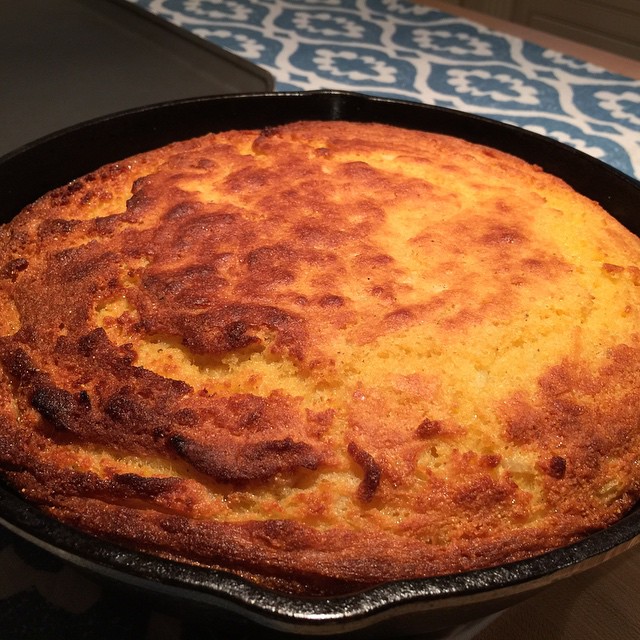
This recipe is pretty basic, except for the addition of sautéed chopped onions. But to this, you may add a myriad of other ingredients, depending on your mood and who you are feeding (see variations). For the most interesting texture, use medium-ground (not fine) cornmeal. And cultured buttermilk is the secret ingredient to making the best-tasting, crispest, (yet incredibly tender) cornbread. (Buttermilk is the secret to so many different recipes that I’ve lost count!) Using an old-fashioned, well-seasoned cast iron skillet ensures the crispest, most authentic results. Today, you can even buy pre-seasoned cast iron pans. In a pinch, a heavy round cake pan will do.
The sautéed onions can be omitted. Or, while sautéing the onions, add 1 or more of the following: 1/3 cup minced red or green bell pepper; 1 chopped, stemmed and seeded jalapeño chili pepper and/or 1/3 cup chopped hard sausage (andouille, or pepperoni, or chorizo, with the casing removed); you can also sauté 3 pieces bacon, until crisp, drain and coarsely chop. Then sauté the onion in 1 tablespoon of bacon drippings instead of the butter and add chopped bacon when assembling butter. Another variation is to sauté 1/3 cup crumbled fresh sweet or hot Italian sausage in a bit of olive oil until golden; pour out any accumulated fat and add onions and 1 clove of minced garlic.
Any time I’ve suggested a tool, a piece of equipment, or a culinary term that’s unfamiliar to you, you can go to Learn to Cook for more information.
Place a 10-inch cast iron skillet or heavy cake pan on the center shelf of the oven. (If using a cake pan, brush or spray the sides with flavorless vegetable oil.) Preheat the oven to 425º F.
Heat a small skillet over medium heat with 1 tablespoon butter. When melted and bubbling, add minced onion and sauté until softened and fragrant, 2 to 3 minutes. Add some freshly ground black pepper, remove from heat and set aside.
Place cornmeal, flour, baking soda, salt and sugar in a medium-sized mixing bowl. Using a whisk, combine well and then sift into another bowl. Pour buttermilk into a separate bowl; add lightly beaten eggs and cooled sautéed onions and mix well. Pour buttermilk mixture and sautéed onions into the bowl with the dry mixture and add melted butter with another grind or two of fresh black pepper. Using a wide blending fork or a batter whisk, gently combine mixture until there are no dry pockets.
Place clarified butter or solid shortening into the preheated pan while it remains in oven. Close oven door and allow the fat to liquefy and become hot (1 minute). Open the oven door and carefully (using oven mitts!) pull the rack holding the skillet toward you. Using a rubber spatula, somewhat quickly (so the oven doesn’t cool) pour cornmeal mixture into the hot skillet (the batter should sizzle furiously). Push the pan back into the oven and close the door. Bake until firm but not overly dry and a toothpick comes out clean when inserted into the center of the bread, about 20 minutes. Meanwhile warm your serving plate.
Carefully remove pan from oven and run a knife around its circumference. Place a flat cookie sheet or a wire rack over the top and invert bread onto rack. Immediately invert once more onto a warmed serving plate so bread is right side up. Cut into wedges and serve hot with softened butter.
The dry ingredients can be mixed, sifted and left in a covered bowl days before needed. Just give a good swish with a whisk to combine and lighten before assembling.
Although batters leavened only with baking soda should be baked soon after being assembled, this batter can be fully combined, covered and left at a comfortable room temperature for up to 1 hour before pouring into the preheated skillet. Or, for best results, simply combine the dry ingredients in one bowl and the wet ingredients in another and refrigerate the latter–hours ahead. Add the sautéed onions to the wet ingredients and allow them to sit out at room temperature for 1 hour before combining wet and dry ingredients (along with melted butter) just before baking.